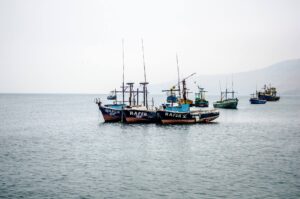As free trade expands, each
one percent increase in per capita
incomes tends to drive pollution
down by 1.25 to 1.5 percent because
of the movement to cleaner techniques
of production.
Rock-throwers at World Trade Organization meetings call themselves environmentalists. They protest that international trade is environmentally destructive, because it induces the emergence of “pollution-havens”—Third World nations that take on the dirty work of tanning leather, making paper, and the like. These nations become polluted and, it is claimed, total environmental damage also increases.
Many economists are skeptical of the pollution-haven story, but the contention that trade harms the environment is difficult to assess systematically. The links between trade and the environment are subtle and complicated, and simply measuring such concepts in a convincing way is daunting. Recent research has made huge strides in cracking this problem and provides us with a compelling conclusion: Freer international trade improves the environment (Antweiler, Copeland, and Taylor 2001).
Whether it is between people, states, or nations, trade can have an impact on environmental quality through three channels. These are changes in (i) where goods are produced, (ii) the scale of economic activity, and (iii) the production techniques used. Antweiler et al. are able to distinguish the effects of each of these on environmental quality.
Interestingly, changes in the location of production—the pollution-haven hypothesis—turn out to be empirically unimportant. The fact that freer trade induces increases in the scale of economic activity, on the other hand, has a modest adverse impact on environmental quality. But the third effect—changes in production techniques—swamps the other forces, and it is environmentally beneficial, not harmful. Overall, the authors estimate that for each one percent that freer trade raises per capita income in a nation, the result is that pollution (as measured by sulfur dioxide concentrations) falls by one percent.
When trade expands, the composition of output from each nation changes because trading partners can now exploit their sources of comparative advantage—doing more of what each does best and less of those things at which each is not very good. Anti-trade protestors have argued that comparative advantage moves dirty production processes to developing countries, polluting these nations and increasing overall environmental damage. What this claim misses is that a staggering array of factors help determine the location of productive activity. Even for pollution-intensive goods, considerations other than pollution-abatement costs—such as capital abundance, labor market cconditions, and transportation costs—are generally the determining forces. On balance, the authors find little impact on the environment due to trade-induced changes in the location of production.
The other effects of freer trade—increases in the scale of activity and changes in the techniques of production—are more important. Simply increasing the scale of economic activity means more material goods are produced, so more byproducts are formed, causing air and water pollution. This tends to reduce environmental quality. The authors find this effect clearly, albeit modestly, present in the data: Each one percent rise in economic activity induces about one-quarter of one percent rise in pollution concentrations due to this force.
Overall, however, Antweiler et al. find that this negative effect is overwhelmed as economic growth, spurred by trade, takes place. When people get richer they demand more environmental amenities. As free trade expands, each one percent increase in per capita incomes tends to drive pollution concentrations down by 1.25 to 1.5 percent because of the movement to cleaner techniques of production.
The conclusions one can draw from this research are limited in two dimensions. First, sulfur dioxide concentrations are the sole measure of pollution used in this paper, a fact driven simply by the need to select some measure. Free trade might worsen other measures of pollution, but sulfur dioxide concentrations are known to move closely with other airborne emissions. Hence, it seems unlikely that alternative measures of pollution would yield much different conclusions.
Second, the authors do not investigate exactly what regulatory or institutional changes are driving the environmental improvement caused by rising incomes. In principle, the rising demand for environmental quality might get translated into environmental improvement through explicit government pollution abatement policy or through pollution-reducing changes in private contractual arrangements. The authors do not attempt to disentangle the relative roles of these two effects; they can, however, discern the combined effect.
But the nature of these changes is clearly important in the debate over the efficacy of free market environmentalism. If rising incomes bring environmental improvement chiefly due to the growth of intrusive regulatory schemes, the environmentally beneficial effects are likely to be less appealing to many readers of this column. Still, there is little doubt about the quite conclusive finding of this research. In the words of the authors: “Free trade is good for the environment.” Perhaps this will make attendance at future international trade conferences somewhat less hazardous—albeit less interesting—to all concerned.
REFERENCE
Antweiler, Werner, Brian R. Copeland, and M. Scott Taylor. 2001. ? American Economic Review (September): 877–908.
Daniel K. Benjamin is a PERC senior associate and professor of economics at Clemson University. His regular column, “Tangents-Where Research and Policy Meet,” investigates policy implications of recent academic research. He can be reached at: wahoo@clemson.edu




